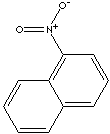|
1-NITRONAPHTHALENE
| ||
|
PRODUCT IDENTIFICATION |
||
| CAS NO. |
86-57-7 |
|
| EINECS NO. | 201-684-5 | |
| FORMULA | C10H7NO2 | |
| MOL WT. | 173.17 | |
| H.S. CODE | ||
|
TOXICITY |
||
| SYNONYMS | alpha-nitronaphthalene; Nitrol; | |
|
SMILES |
|
|
|
CLASSIFICATION |
|
|
|
PHYSICAL AND CHEMICAL PROPERTIES |
||
| PHYSICAL STATE | yellow to green crystalline powder | |
| MELTING POINT | 58 - 60 C | |
| BOILING POINT |
304 C | |
| SPECIFIC GRAVITY | ||
| SOLUBILITY IN WATER | Insoluble | |
| pH |
| |
| VAPOR DENSITY | ||
|
AUTOIGNITION |
| |
|
NFPA RATINGS |
Health: 1; Flammability: 2; Reactivity: 0 | |
|
REFRACTIVE INDEX |
| |
| FLASH POINT |
164 C | |
| STABILITY |
Stable under ordinary conditions | |
|
APPLICATIONS |
||
The prefix nitro- indicates the presence of NO2- radical, while nitrate refers
to any salt or ester of nitric acid or the NO3- anion. Nitroso- is the prefix
indicating presence of the group -NO and azo- is for -N=N- group. Some range of
organic compounds containing nitrogen include nitro compounds (RNO2 ), nitroso
compounds (RNO), amines (R3N ), amino acids, and natural alkaloids or
nucleotides. The nitrogen ion in nitro compounds is trigonally planar with 120°
angles. There are two resonance bonds so that the two oxygens are equivalent.
Nitro compounds are strongly basic due to electron withdrawing both inductively
and mesomerically. Historically, they
are abundant in dyes and explosives. Nitro compounds, organic hydrocarbons having one or more NO2
groups bonded via nitrogen to the carbon framework, are versatile intermediate
in organic synthesis.
1-Nitronaphthalene is used as for the preparation dye intermediates such as 1-naphthylamine (by catalytic reduction), 1-nitronaphthalene-5-sulfonic acid (by sulfonation) and dinitronaphthalenes (by additional nitration). 1-Nitronaphthalene is also used as a component in the formulation of nitrate explosives to decrease the burning rate and as a deblooming agent for petroleum and oils. It is also used as an intermediate to produce raticides. |
||
| SALES SPECIFICATION | ||
|
APPEARANCE |
yellow to green crystalline powder | |
| PURITY |
99.5% max | |
| ISOMER IMPURITY |
0.1% max | |
| MELTING POINT |
57 - 60 C | |
| TRANSPORTATION | ||
| PACKING | 200kgs in Drum | |
| HAZARD CLASS | 4.1 (Packing Group: III) | |
| UN NO. | 2538 | |
| OTHER INFORMATION | ||
|
Hazard
Symbols: T, Risk Phrases: 25-40, Safety Phrases: 28A-37-45
|
||
